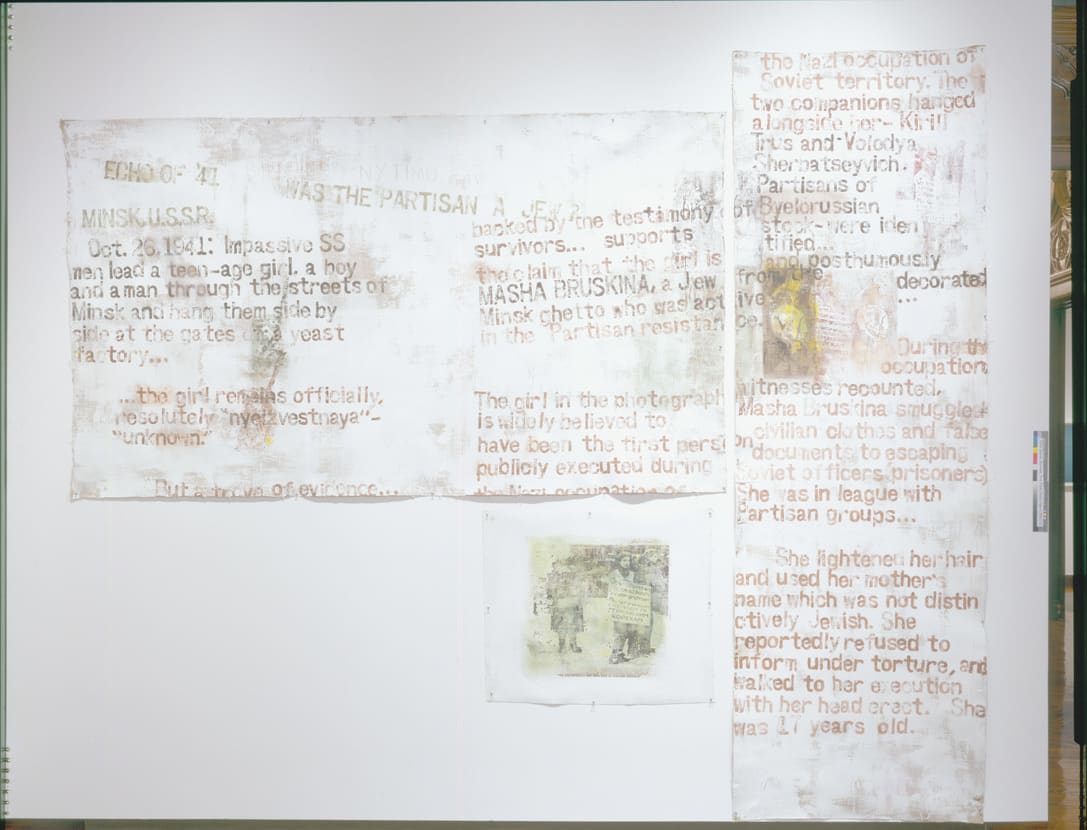
- Artist/Maker:
- Nancy Spero
- Bio:
- American, 1926-2009
- Title:
- Masha Bruskina
- Date:
- 1995
- Medium:
- Acrylic on linen
- Dimensions:
- 122 1/4 × 146 1/2 in. (310.5 × 372.1 cm)
- Credit Line:
- Purchase: Fine Arts Acquisitions Committee Fund, Blanche and Romie Shapiro Fund, Kristie A. Jayne Fund, Sara Schlesinger Bequest, and Miki Denhof Bequest
- Accession Number:
- 2002-12a-c
Not On View
Nancy Spero played an integral role in the feminist art movement of the late 1960s and early 1970s, joining a group called Women Artists in Revolution and developing manifestos and staging protests that demanded inclusion of women in museums and galleries. In 1972, along with five other artists, she created AIR (Artists In Residence, Inc.), the first women's gallery in New York, which paved the way for the recognition of female artists today.
Spero's art addresses how women are represented and often overlooked in history and in the art world. This painting is about Masha Bruskina, a volunteer nurse and leader of the Minsk resistance movement, who is a frequent subject of Spero's work. As the text printed of the canvas explains, Bruskina was a seventeen-year-old Communist partisan who, under the guise of a Gentile, helped wounded Soviet prisoners escape. She was eventually arrested by the German authorities; imprisoned and tortured, she never surrendered the names of other members of her group. She was publicly hanged in 1941, and the Nazis meticulously documented her execution. Many years later, scholarly research revealed her name and Jewish identity, but because of antisemitic sentiment, her Jewishness is still disputed in her home country of Belarus.
Enticing the viewer to decipher the words and digest the images taken from many decades and sources simultaneously, Spero intersperses and overlaps image and text from Masha Bruskina's story. In the background, she prints images of Bruskina's march through the streets to her death and of her execution. The layers of text begin with a newspaper from October 26, 1941, describing the hanging of an anonymous girl by the Gestapo and seamlessly flow into a segment of an article from twenty-five years later, revealing the discovery of this victim's Jewish identity. Spero adds a faint red scrawl to the top of the canvas that refers to Bill Keller, a New York Times reporter who covered the Soviet Union during the cold war, alluding to the way we process the many layers of information delivered by the media.
The three-part, monumental, unstretched canvas with frayed edges is attached to the wall by push-pins. Spero's use of ragged and quotidian materials makes the painting look more like a political banner or wall drawing than a precious, framed icon, and exemplifies the nonelitist principles that pervade the artist's work.
Spero's art addresses how women are represented and often overlooked in history and in the art world. This painting is about Masha Bruskina, a volunteer nurse and leader of the Minsk resistance movement, who is a frequent subject of Spero's work. As the text printed of the canvas explains, Bruskina was a seventeen-year-old Communist partisan who, under the guise of a Gentile, helped wounded Soviet prisoners escape. She was eventually arrested by the German authorities; imprisoned and tortured, she never surrendered the names of other members of her group. She was publicly hanged in 1941, and the Nazis meticulously documented her execution. Many years later, scholarly research revealed her name and Jewish identity, but because of antisemitic sentiment, her Jewishness is still disputed in her home country of Belarus.
Enticing the viewer to decipher the words and digest the images taken from many decades and sources simultaneously, Spero intersperses and overlaps image and text from Masha Bruskina's story. In the background, she prints images of Bruskina's march through the streets to her death and of her execution. The layers of text begin with a newspaper from October 26, 1941, describing the hanging of an anonymous girl by the Gestapo and seamlessly flow into a segment of an article from twenty-five years later, revealing the discovery of this victim's Jewish identity. Spero adds a faint red scrawl to the top of the canvas that refers to Bill Keller, a New York Times reporter who covered the Soviet Union during the cold war, alluding to the way we process the many layers of information delivered by the media.
The three-part, monumental, unstretched canvas with frayed edges is attached to the wall by push-pins. Spero's use of ragged and quotidian materials makes the painting look more like a political banner or wall drawing than a precious, framed icon, and exemplifies the nonelitist principles that pervade the artist's work.
Information may change as a result of ongoing research.